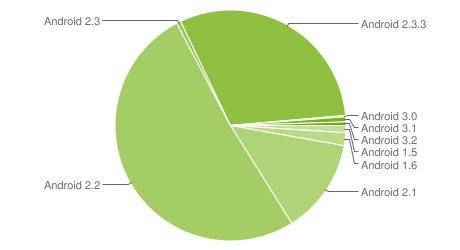Why Android Smartphones So Rarely Get Updates?
Android smartphones get operating system updates, usually only with delays, if any. This is due to complex interplay between Google, the smart phone manufacturers and providers. There is little remedy: Creating Self-hand, just buy the Nexus models from Google – and in our table to see which manufacturer advises the customer on the longest.

For a cell phone you need not really a fix, you might think, because you have it so chosen because of existing features, and not because of any future resulting from the purchase were not even known. But the demands of smartphones are higher: sometimes desirable features are added, sometimes require a new version of Android apps, and sometimes you have a bug can be eliminated.
So that’s Milestone one of the most popular Android devices at all, until Motorola is due to the delay in updates forfeited to version 2.2 with the buyers. They could not install any new apps more, without having to uninstall the old one, because the internal memory was full. Android 2.2 can work around that by apps installed on the SD card. Buyers of Samsung Galaxy Tab wait until today to Android 2.3 , Dell Streak 7 gets the update on Android 3 with several months of delay – in the meantime had even Dell all hopes of an update undermined .
A new version of Android is running first on any phone at all – though Google has done it, the work begins for manufacturers and providers in the first place. Device manufacturers will decide which units they come out, and then build a version for each device with its own specialities, such as drivers or user interfaces. Some provider settings such as MMS configuration or APN lists are added, which at over 1000 worldwide mobile network operators (excluding resellers), however, does not work without error. Updates for branded phones also build together with the manufacturer, which provide them with the necessary data provider.
 According to these numbers from Google Spetember 2011 are now over 80 percent of Android devices with 2.2 or later. Now begins the testing phase of the manufacturers. For provider-specific versions of the lead provider by further tests. According to Vodafone’s blog they edit annually more than 500 updates for smartphones and mobile phones. For example, would test the accuracy of mobile positioning, the acoustics of the call setup, the couplings to Bluetooth devices or the correct APN settings depending on the contract. Even with small updates can be hundreds of individual tests, with larger jumps operating system (and new equipment) quickly come together several thousand tests, such as an O2 employee reports in a blog entry. New operating system versions need it for the provider to test each model separately, are too large, the adjustments to the manufacturer.
According to these numbers from Google Spetember 2011 are now over 80 percent of Android devices with 2.2 or later. Now begins the testing phase of the manufacturers. For provider-specific versions of the lead provider by further tests. According to Vodafone’s blog they edit annually more than 500 updates for smartphones and mobile phones. For example, would test the accuracy of mobile positioning, the acoustics of the call setup, the couplings to Bluetooth devices or the correct APN settings depending on the contract. Even with small updates can be hundreds of individual tests, with larger jumps operating system (and new equipment) quickly come together several thousand tests, such as an O2 employee reports in a blog entry. New operating system versions need it for the provider to test each model separately, are too large, the adjustments to the manufacturer.
After that, Google intends to certify the devices with the new version mostly still.Occur during the testing and certification problems, the development department of the equipment manufacturer ran the test again and starts over.
After passing the certification by Google, the equipment manufacturer and, if the provider will begin the preparations for the distribution: Share files, translated help texts in all languages ??required, service representatives inform, make sure to give all users the right version for your device and the like. Then finally, users can access update again, either by download or on a PC now often directly via download on the device itself.
Shortlink:

Recent Comments